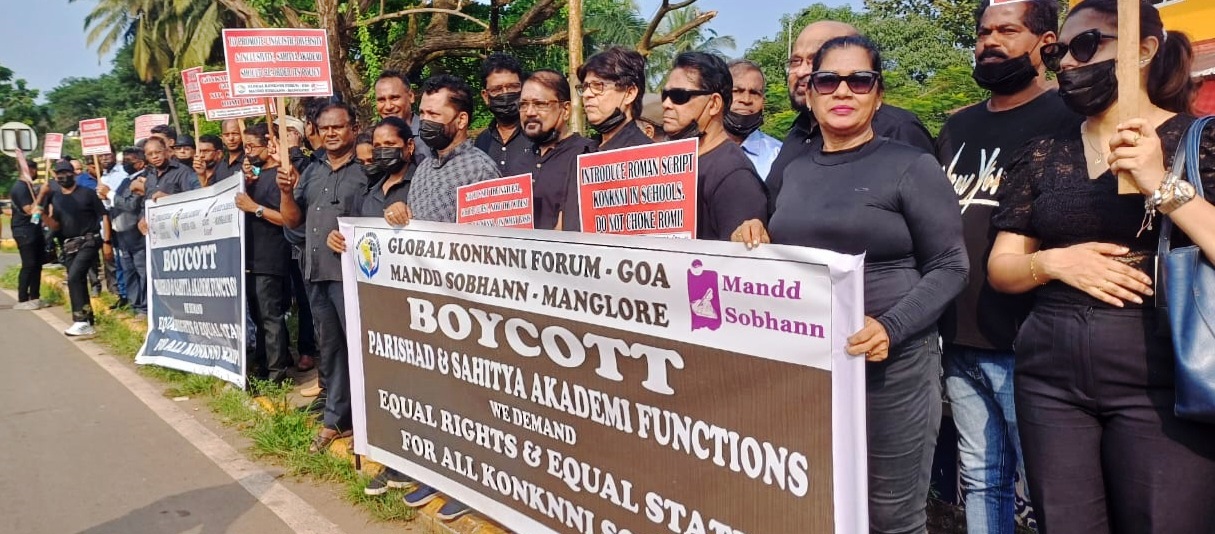One begins to wonder: where does Prof Devy's figure of 1,500-2,000 Konkani books produced every year come from?

On the weekend, the 33rd All India Konkani Parishad session was held in Margao. It has been described as "a national conference held in India... meant to support the Konkani people and Konkani language, and conducts various activities to achieve that goal, aided by local authorities".
Perhaps for the first time, the meet was held against the backdrop of protests. Romi and Kannada script campaigners, dressed in full black, with their mouths gagged with cloth bands, were protesting against the sidelining of their scripts by the Nagari-alone lobby.
The latter has gained the most from the inexplicable and hurriedly passed Official Language Act, 1987. Even though this Nagari-alone approach was never on the agenda, the then Congress politicians, in a house lead by Pratapsing Rane, chose to grant official language status to the Nagari script of Konkani alone. A "compromise" doomed to never work.
They did so knowing fully well that Konkani was actively written in two scripts in Goa, with Romi being the more popular, widely used and longer-used script.
The noted cultural activist, literary critic and former professor of English Ganesh N. Devy was the chief guest. As expected, the father of the People's Linguistic Survey of India spoke in an engaging, engrossing and entertaining manner. Except that, this time round, his argument, though very catchy, was based on questionable statistics and facts.
In his speech, Prof Devy said: "I was told some time back that, in Konkani, close to 1,500-2,000 books are being produced every year.... Among the scheduled languages of India, Konkani is the highest book publishing scheduled language in the entire country." Applause.
This is quite untrue. The numbers of books published in each language, every year, are well known.
The Rajhauns Goa Saunskrutik 2024, a cultural directory published annually, in fact, has all these details. It lists the number of books -- language-wise -- at the Krishnadas Shama Goa State Central Library, yearwise, since 1974. As per the law, all books published in Goa are to be 'deposited' at the Central Library.
In all languages put together, Goa unfortunately does not produce more than 300 books in a year! That includes Nagari Konkani, Romi Konkani, Marathi, English, Hindi, Portuguese, Sanskrit, French and the rare book in Telugu too. We should have had many more.
For instance, in 2023, the number of books published were 91 in Nagari Konkani, 25 in Romi Konkani, 101 in Marathi, 149 in English, four in Hindi, and one each in Sanskrit and French. By contrast, in 1974, the figures were as follows: 10 in Nagari, none in Romi, seven in Marathi, five in English, two in Portuguese.
The largest number of Nagari books published was 120 in 2019. Romi Konkani peaked in 2012 and 2022, when 37 books were published each year. You get the drift. English has grown from single digits till the mid-1980s; the highest it touched was 170 in 2018.
This is for Goa alone. It largely covers Nagari and Romi scripts. By the admission of the Nagari advocates, publishing of books in the Malayalam and Perso-Arabic scripts has virtually stopped.
That leaves us with Kannada-script Konkani, another script which also feels disempowered (it is out of the running for Sahitya Akademi acknowledgements). Figures of books in this script range from a high of 300 per year (web search). Maybe less. Those who know the field, say the number of books published in Kannada script Konkani could not be "more than 50 (including religious books)". Then, because of poor readership, day by day the print media is diminishing.
So, put this all together, and one begins to wonder: where does Prof Devy's figure of 1,500-2,000 Konkani books a year come from?
The thrust of Dr Devy's argument focussed on this point, about how well Konkani is fighting back to revive itself, despite all its past odds, and he based it on the number of books published.
Together with this, there is the side argument of how Konkani has faced discrimination all along its history. Its texts were burnt, and "edicts" sought its banning. This does create a dramatic image about what the language has gone through, but how much of it is based on fiction and stereotype?
Time and time again, the 1694 edict banning the use of Konkani is cited. The Inquisition is used as a short-form argument; repeating untruths might make something seem like real. We are told that the "literature of Konkani" was destroyed, though researchers point out that this was mainly a spoken language then.
Konkani gained from the earliest printing in India, if not in Asia. Its old texts have been preserved, and copies retrieved, from Portugal even in recent decades. Check these out at the Central Library.
European scholars from a range of nations, have studied Konkani and/or Marathi. These include English Thomas Stephens or Tomás Estêvão, the French Étienne de la Croix, the Spaniard João de Pedroza, the Italian Ignacio Arcamone, the Africa-born António de Saldanha and the Portuguese Diogo Ribeiro, Miguel de Almeida, Simão Gomes and Dom Francisco Garcia, among others.
The rich literature they produced in both languages, especially in Konkani, resulted in grammars, vocabularies and religious literature. Quite a few remain in the manuscript form "in different libraries throughout the world, e.g. Goa, Italy, Portugal, Spain, France, England, etc," as Prof Newman Fernandes notes. But, as we mix politics with uber-nationalism and a tinge of communal perspectives, this reality doesn't fit in with the narrative.
Our narrative is now to create a peculiar victimhood for Konkani, and then to see it as rising against the odds. Both are exaggerations. But such claims help one script to dominate and seek to extinguish four others. It is even more sad that scholars of repute like Prof Ganesh Devy should fall in this trap.